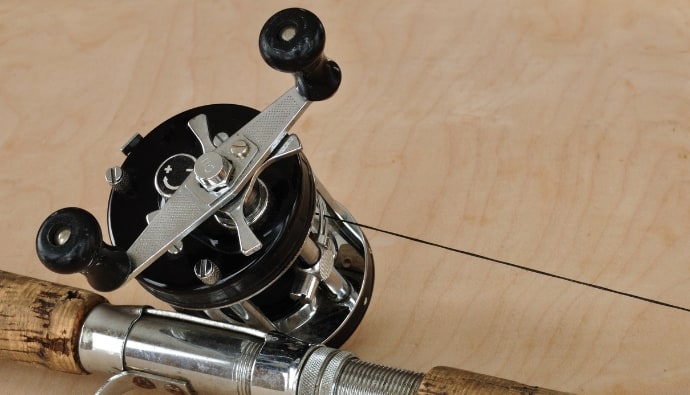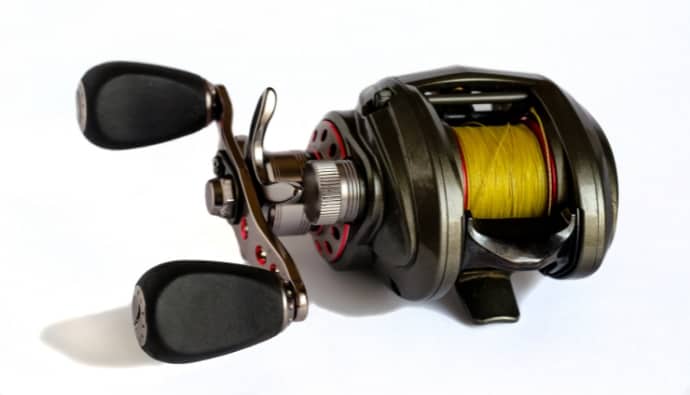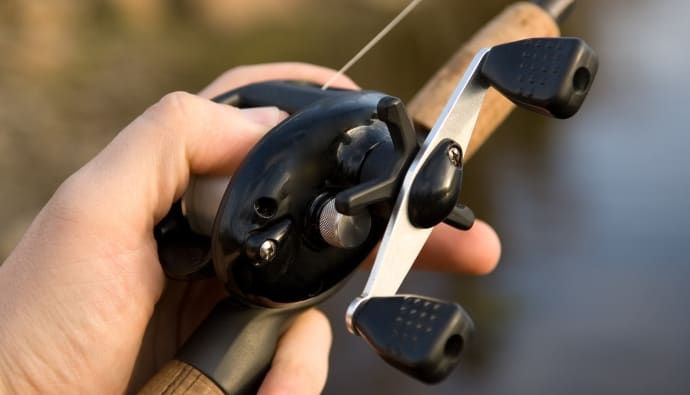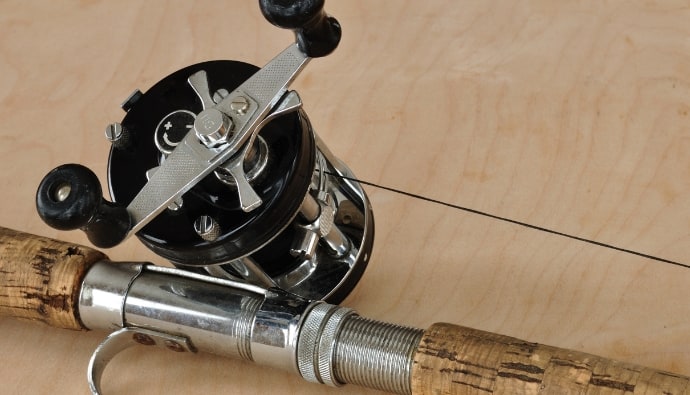Understanding your reel parts can be overhelming. It seems like every year manufacturers add more complexity and innovations that make catching fish easier, but at-home repairs a challenge. In this article, we share with you what we’ve learned over the years when it comes to all things fishing reels.
Overview

Fishing reels are essentially just line management tools that are attached to some type of fishing rod.
The function of line storage has to do with the ability to contain a sufficient amount of fishing line. This is to allow for continuous fishing in the chance of a tangle or break off.
A fishing reel also needs to contain enough line to put up with long runs from fish during the fighting process.
As well as line capacity, a fishing reel needs to be able to allow the line to move out freely under pressure. This is applied by the drag brakes in the reel itself during the act of fighting a fish.
Functions like these are granted through many different means. This results in multiple categories of reels.
Reel Spool Types
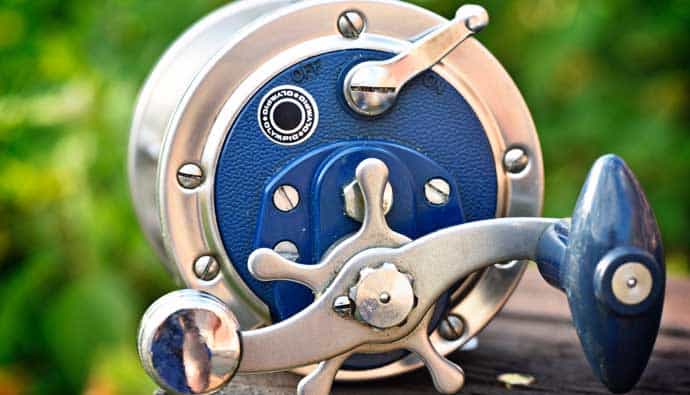
Reels can be divided up into two major groupings depending on the type of spool a reel is designed with.
When it comes to freshwater fishing, there are three main types of fishing reels, spinning reels, spin-cast reels, and baitcasting reels.
Spinning reels feature a spool that is exposed at all times and has a flip-open bail. This bail releases the line and allows for casting.
Spincasting fishing reels are very similar to spinning reels in the spool type. The difference is the spool on spin casting reels is covered at all times. It also has an easy push button to allow for casting without any extra motions.
Baitcasting reels are in a class of their own due to the fact the spool is uncovered at all times. As well as the fact they have a push-button release that allows for casting.
What makes a baitcasting reel unique is the brakes. They slow down the speed at which the spool turns when casting, which allows for a more accurate cast.
Read Also: Best Fishing Line Spoolers
Reel Body Materials
The creation of fishing reels requires a fairly large investment in dies, tooling, designs, and computer design or manufacturing software.
Many manufacturers have stuck to the use of metal. Although, there are others that only use high-grade plastics to create their reels.
Both body types of reels have their pros and cons. Metal is stronger but weighs more. Plastic is cheaper to create and is lighter but lacks the strength of the metal.
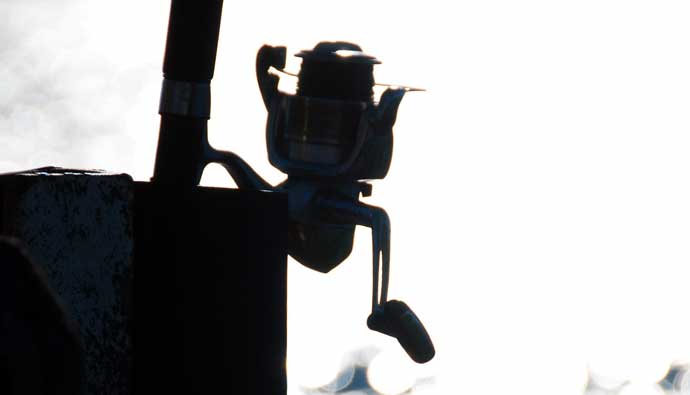
Metal Reels
The metals that are used to make reels range from die-cast alloys to CNC’d high-tensile strength aluminum and steel.
For a certain sized part, metals are generally stronger than high-grade polymers. This is still true even with the lowest quality cast alloys.
For this reason, almost all of the internal gears in any given reel are going to be an alloy. Whether it be the cheapest reel or the most expensive money can buy.
Metals are stiff and rigid by nature and almost always maintain precise alignment between gears. Even when they are subjected to high amounts of stress.
Metals achieve durability through the superior wear properties of metals.
Most alloys are chosen simply for the frame but are also chosen for the load-bearing areas in the reel.
The negative side of metal fishing reel bodies is:
- weight
- corrosion resistance
- apparent lack of shock absorption and resistance.
Aluminum alloys are used for most metal reel components. It adds almost a three times decrease in weight but what it lacks in weight it also lacks tensile strength.
Metal reels almost always require maintenance on the surface of the reel to keep corrosion and rust from forming.
More so in a saltwater environment than freshwater due to the extra corrosion properties in the salt from the ocean.
Plastics and Graphite Reels
Fishing reels made out of polymer (which is sometimes known as graphite) can be a good alternative to heavier metal reels.
A polymer is a compound made from common plastics. It’s reinforced with fibers to create a strong compound that works for anything from gun parts all the way to fishing reels.
The polymer is injection molded into the shape in a method that is economical for mass production.
The positive features of plastics and polymer when it comes to fishing reels is one, the reels are very easy to make on a large scale.
As well as the fact that the reels are lightweight and very resistant to corrosion.
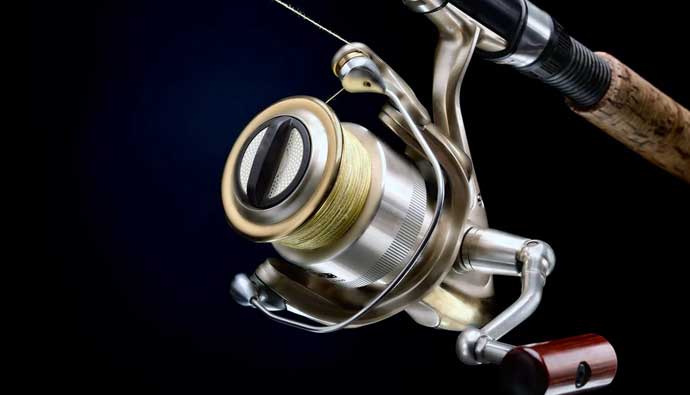
Cost of Materials
When it comes to the parts of a fishing reel, the cost of materials is a hot topic. When using plastics are almost six times cheaper to make on a large scale versus their metal counterparts.
As well as the economical positive factor, a polymer is almost one hundred percent resistant to corrosion. This means that plastics and polymers do not require any surface finishing.
Although polymers do not require a final finish, some companies add a vacuum deposited finish. This makes the compound look metallic to add to the aesthetic of the fishing reel.
The negative factor of plastics and polymers is distortion due to wear from heavy loads over time.
Understanding Polymers
Polymers retain a degree of flexibility to keep the compound from becoming brittle. Especially in low temperatures where the compound can freeze and shatter. Imagine dropping a cold reel on a rock or the ice.
Polymers shatter and fracture much like a sheet of glass when exposed to extreme cold.
Polymers do have some self-lubricating properties. However, it a naturally soft and can wear quickly, especially when sand, dirt, and grit are thrown into the equation.
Although metal and polymer reels have their ups and downs, the negative features of both materials can be avoided through minor maintenance.
Usually, the bad aspects of the material are exponentially higher when there is a significant level of neglect of the product.
Reel Bushings and Ball Bearings
The task of bushing and ball bearings is to support a rotating shaft with minute amounts of friction.
In revolving and fixed spools, a rotating shaft supports the handle and gear train.
An angler rotates and cranks the handle to retrieve, which without bearings can be a very rough action that can cause the gears to break under stress and pressure.
Bushings
A bushing sometimes known as a sleeve bearing supports the rotating shaft with a very smooth finished hole as well as a lubricating film. This keeps the shaft turning freely without a catch.
For smaller loads, the body material Zamak, which is a zinc and aluminum alloy with high machining characteristics, is the ideal bushing material.
Bushing materials that are different from the reel body are used for higher loads and include but are not limited to brass, bronze, as well as highly reinforced fibers.
Bushings are usually firmly pressed into the reel or even adhered to the reel body. Generally, the rotation of the bushing would wear an oversized hole in the reel body.
The bushing materials are chosen to optimize its mechanical properties. Including abrasion resistance and low friction.
The alloys are usually formed from granules much like a graham cracker crust in a pie. Due to the porous structure, it allows either the free passage of lubricants or the storage of lubricants. This grants a longer life to the bushings.
Ball Bearings
The main advantage of ball bearings over bushings is when under heavy load conditions.
When under low load conditions, there is almost no distinguishable difference.
But as the load increases on the drive shaft, the difference between bushings and ball bearings is very much so noticeable.
The difference can be compared to moving a car with and without wheels.
The rolling action of ball bearings depends very heavily on the heavy-duty construction of its structure.
Coming second to that is the vast importance of lubrication. This allows a lot of play in the bearing making it smoother and easier to crank the drive shaft when under heavy loads.
Most mass-production fishing reels are designed with both bushings and ball bearings. This is mainly because the cost differential is much more.
Although, the higher quality reels contain a higher number of ball bearings and have a longer life expectancy under rougher conditions.
Reel Cantilever Supports
Most rotating shafts are supported on both ends, some designs are cantilevered or supported at one end only. Some fly casting reels are an example.
The spool is supported on a shaft that is cantilevered to the side plate.
In other cases, the flex of cantilevered designs can seriously affect the performance under a heavy load. This is because the engagement becomes compromised, and very severe wear can and will result from it.
Reel Lubrication
When it comes to the parts of a fishing reel that move, it’s important to remember that friction is your enemy.
The main purpose of lubricants is to reduce wear. Greases are generally used to lubricate bushings, gear teeth, and sliding shafts to prevent direct metal contact.
Suitable greases that are sold through fishing manufacturers are usually lithium-based with other additives such as graphite. This extends the life and productivity of the grease to keep your reel working all day every day.
Flaked Teflon is fairly expensive and is generally used for drag washer lubrication.
The same ‘non-stickiness’ that is used on cookware is in the grease which adds an extended level of lubrication other greases cannot produce.
Light oil lubricants are used on the ball bearings around the shaft of the wheel.
If you use heavy grease or heavy oils it can impede the performance of the ball bearings causing them to slow down and not move as freely.
Reel Drag
Drag is essentially a clutch that when engaged tightens down and creates friction. This causes resistance to the fish when hooked from the line free spooling back to the fish.
When the drag is tightened down the fish has got to pull harder in order to get the line to release back to it. However, when the drag knob is loosened the fish does not have to put much at all in order for the reel to give line back.
A drag system needs to be able to go from completely loose, to 30-50 percent of the lines breaking strength all the way to full lockdown in a matter of a small adjustment.
Parts of a Fishing Reel – Gears
The main components in a reel are the gears, the second the handle is turned the gears engage and are either retrieving a lure or fighting a fish.
The number of pressure gears that can be put up depends on their quality and design of them.
Gear Basics
The typical gear set in a reel is the drive gear, pinion gear, or level wind gears. But will also sometimes have a transfer gear.
The drive gear and pinion gear define the speed and durability of the reel.
The drive gear is usually linked directly to the rod handle in a spinning reel. It is indirectly linked through the drag system in a baitcaster or conventional reel.
The main purpose is to retrieve the line that is out after casting.
The pinion gear is usually a lot smaller than the drive gear. And depending on how it is designed, can either speed up or slow down the gear ratio of the reel’s retrieve.
It is common for the pinion gears to be made out of brass and the drive gears to be made out of aluminum. This creates a pair of gears that will last years if taken care of well and can put up with most small amounts of the grit of machining malfunction.
Almost all higher quality reels have helically machined gears which in turn creates a more efficient and higher quality product in the end. This is through meticulous quality control.
The best way to prolong the life of your gears and your reel is through regular maintenance.
This in turn means regular cleaning and greasing of the gears which keeps them at 100% at all times.
Gear Ratio
When it comes to the gear ratio, a higher number of teeth on a drive gear and a lower number on the pinion gear create a fast gear ratio.
This is versus a higher amount on the pinion gear makes it to where you have to turn the drive gear more in order to get a full revolution from the pinion gear.
If a drive gear has 60 teeth and the pinion has 12 teeth, the gear ratio would be 5:1 since the pinion gear would turn 5 times before the drive gear turns once.
Two Gear Reels
There are two-gear reels in baitcasting and conventional, but there has yet to be a two-gear reel in a spinning model.
A two-gear reel is a reel with a significantly higher ratio gear for working baits and a crawling smaller gear for when a fish hits the bait and is on the line.
In complex models, the gear changing is put into action by the movement of the handle. However, in simpler models, there are buttons or switches that change between the two gears.
This is to give the angler more time to fight the fish instead of fiddling around with the reel in the heat of the battle.
Line Recovery
In order to determine what is a useful speed, the gear ratio must be paired against the size of the spool.
It really does not matter how fast your gear ratio or spool turns. If you have a small spool, it will not matter as the amount of line recovered would be very small versus a reel with the same gear ratio and a larger spool. Which gives more turning surface area.
Cranking Power
A reel can have a high gear ratio and pull in a large fish but not without extra fatigue due to the lower amount of cranking power.
When it comes to cranking power and large fish, lower gear ratios is where the money is.
A reel with a lower gear ratio has bigger teeth on the drive and pinion gears which in turn make it a lot stronger when it comes to pulling in a very large fish.
The higher gear ratios tend to have smaller teeth. This, in turn, has lower cranking power as the smaller gears tend to be a little bit rougher and easier to break or shave off in the heat of a battle.
Well there you have it, the parts of a fishing reel!
Insider Advice
We hope you enjoyed this deep dive into the parts of a fishing reel you should know about. Whenever you get a new reel be sure to grease the drag to keep it alive longer.
If you’re fishing saltwater, don’t forget to rinse it off after each use with fresh water to prevent corrosion.




 Facebook
Facebook YouTube
YouTube